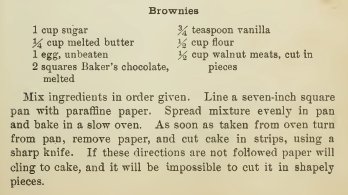

History of Brownies
(Chocolate)
February 2010
Printer Friendly Version (PDF)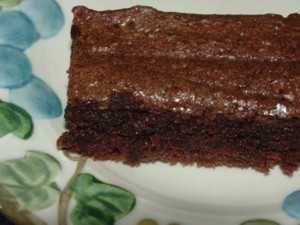
History
This is an updated history with new source materials and print outs of older source materials. It pushes the first published “chocolate brownie” recipe back to 1904. However, more sources are needed to accurately complete the history. Does anyone have access to the following Boston Cooking School Cook Book editions: 1900, 1901, 1902, 1903, 1904, 1905, 1906, or any other editions up to 1910? A print out or accurate copy of the brownies recipes in those editions is needed.
1893
Palmer House Hotel
“This dessert was created in the kitchen of the Palmer House Hotel during the 1893 Columbian Exposition when Mrs. Bertha Palmer requested the chef make a “ladies dessert” that would be easier to eat than a piece of pie, and smaller serving than a slice of layer cake, which could be used in box lunches at the Women’s Building at the Fair.” “This recipe is still served today at the Palmer House Hilton on State Street and is one of their most popular confections.”
- From Epicurious.com submitted by Laureen2000food submitted March 29, 2009
The popular confection is called the Palmer House Brownie which is topped with an apricot glaze. The Palmer House Hotel’s recipe given in the article does not state if it is the original recipe or a modified version. The Palmer brownie calls for double the quantity of chocolate that normal brownies recipes use and an apricot glaze. The extra chocolate and glaze is not found in the 1904 - 1910 published chocolate brownies recipes. It seems unlikely the hotel’s recipe was copied.
Recipe Formats
Up to 1880 ingredients in recipes were given in paragraph form. In Mrs. Linclon’s 1884 edition of the Boston Cooking School Cook Book she changed the format in the cake section. She formed two columns and listed the ingredients. At the bottom of the columns she wrote out the instructions in paragraph form. This format took a while to trickle down to the everyday housewife who submitted recipes to community cook books. The 1904 Home Cookery compiled by the ladies of the Congregational Church (Laconia, NH) has a good example. The Brownies recipe submitted by Mrs. C.F. Pitman was taken from Fannie Farmer’s 1896 Boston Cooking School Cook Book. It changes the modern format of listing the ingredients in two columns back to a paragraph format. The two recipes are identical, otherwise. Since individual cooks took it upon themselves to change the format in how a recipe was presented the format can not be used to date a recipe. The old recipes presented in this article have been converted to a standardized format so the ingredient list can easily be compared.
The Name “Brownie”
Author Palmer Cox popularized the name “Brownie” with the publication of his book The Brownies, Their Book in 1887. With the rise in popularity of the book, commercial businesses developed advertising tie-ins to the name. For example, Kodak names its popular camera “Brownie,” various candy companies use “brownie” in the name of their chocolate candy treats, Sears & Roebuck Co. name use the name for a cookie.
[Molasses] Brownie (small cake type)
1896
Boston Cooking School Cook Book (1896), page 424
Boston, Massachusetts
Brownies
1/3 cup butter
1/3 cup powdered sugar
1/3 cup Porto Rico molasses
1 egg, well beaten
7/8 cup flour
1 cup pecan meats cut in pieces
Bake in small, shallow fancy cake tins, garnishing top of each cake with one-half pecan
1904
Home Cookery (1904, Laconia, NH) page 132
Recipe submitted by Mrs. C. F. Pitman
Brownies (Molasses Cakes)
1/3 cup butter
1/3 cup powdered sugar
1/3 cup Porto Rico molasses
1 egg, well beaten
7/8 cup flour
1 cup pecan meats cut in pieces
Bake in small, shallow fancy cake tins, garnishing top of each cake with one-half pecan
This recipe is identical to the Brownies recipe in the 1896 Boston Cooking School Cook Book except that is was written out in paragraph format instead of Fannie Farmer’s listed format. (It was reformated to list format for ease of comparison)
Brownies (Cookies)
1897
Sears, Roebuck Catalogue 1897, page 16, 3rd column
Fancy Crackers, Biscuits, Etc. (Biscuits was misspelled it had a D instead of a B)
(Biscuits are semi-sweet English style cookies)
Brownies, in 1-lb papers …… Doz. $1.50 Each $ .14
1905
Home Cook Book, Practical Recipes by Expert Cooks (1905, New York) page 315
Brownies (cookies)
¼ lb. [½ cup] butter
¼ lb. [½ cup] granulated sugar
2 eggs
Grated Rind of a Lemon
4 oz. [4 squares] grated chocolate
½ cup milk
pinch of salt
1 lb [3 cups] flour
“Stir briskly together, roll out and cut in brownie or other shapes …”
Brownie Candies
1898 Candy Ad
The Kansas City Journal, Friday, April 1, 1989, page 12, Newspaper Advertisement
Emery, Bird, Thayer & Co.
Confections
Chocolate Brownies, regular
Price 50 cents pound for …………15 cents
1901 Candy Ad
The Minneapolis Journal, March 29, 1901, page 5, 1st column, Newspaper Advertisement
Easter Candy
Chocolate Brownies, each……5 cents
1903 Candy Ad
The Washington Times [D.C.], Sunday. December 13, 1903, page 16, Newspaper Advertisement
Kann & Sons & Co.
Christmas Candies
Chocolate Brownies ….. 12 cents a pound
1905 Candy Ad
The Washington Times [D.C.], December 22, 1905, page 3, bottom right, Newspaper Advertisement
Christmas Candies
Chocolate Brownies ….. 12 cents a pound
1907 Candy Ad
The Washington Times [D.C.], December 20, 1907, page 5, bottom center Newspaper Advertisement
Christmas Candies
Chocolate Brownies ….. 12 cents a pound
Unknown Type
1904
Mansfield (OH) News, July 13, 1904, pg 5, col.4, Newspaper Advertisement
The Latest
Frozen Fudges
and
Neapolitan Cakes
and
Lemon Wafers
and
Chocolate Brownies
Loiselles
Bread and Milk Co.
“Chocolate” Brownies Recipes Neither Cake, nor Candy, nor Cookie
1904 Home Cookery Brownies (p 132) 1904 Service Club Cook Book Bangor Brownies (p 68) 1905 Boston Daily Globe* Bangor Brownies (p 34)
Laconia, NH
Recipe submitted by E. P. Quniby
½ cup butter
1 cup sugar
2 squares chocolate
2 eggs
½ cup flour
½ cups chopped nuts
a little salt
1 teaspoon vanilla
“cut into bars”
Chicago, IL
½ cup butter
1 cup sugar
2 squares Baker’s Chocolate
2 eggs
½ cup flour
½ cup chopped walnuts nuts
“Spread on baking tins”
Boston, MA
½ cup butter
1 cup sugar
2 squares chocolate
2 eggs
½ cup flour
½ cup broken walnuts meats
“Spread thin in buttered pans”
“Cut before cold”
*April 2, 1905 p.34
The first two published chocolate Brownies recipes show up simultaneously in 1904 in New Hampshire and Illinois. These are very different geographical regions one is on the east coast and the other is in the mid west. Both are community type cook books by women’s groups: Congregational Church of Laconia, NH and Service Club of Chicago, IL. These two 1904 recipes have slight variations: the Chicago, Illinois recipe is called “Bangor Brownies” and called for Baker’s Chocolate. Baker’s Chocolate established in 1780 was a Dorchester, Massachusetts company. The New Hampshire recipe is called “Brownies” and called for chocolate squares with no company name attached. The New Hampshire recipe also called for vanilla which did not show up in the Bangor Brownie recipe. Otherwise, New Hampshire’s basic recipe is identical to the Illinois recipe. In 1905 the Boston Globe published a Bangor Brownies recipe identical to the Chicago, Illinois Bangor Brownies recipe except it does not reference Baker’s Chocolate.
These three earliest published brownies recipes with exactly the same quantity of ingredients with one exception, the addition of vanilla to one of them from three different states, suggests there was originally a single source for the recipe. But what was that source?
1907 Lowney’s Cook Book Bangor Brownies (p 261) Lowney’s Brownies (p 265) 1910 Revised Edition Boston Cooking School Cook Book Brownies (p 495)
Boston, Massachusetts
¼ cup butter
1 cup brown sugar
3 squares chocolate
1 egg
½ to ¾ cup flour
1 cup nut meats
¼ teaspoon salt
“cut in strips”
½ cup butter
1 cup sugar
2 squares Lowney’s chocolate
2 eggs
½ cup flour
½ cup nut meats
¼ teaspoon salt
“cut in squares”
Boston, MA
¼ cup butter
1 cup sugar
2 squares Baker’s Chocolate
1 egg
½ cup flour
½ cup walnut meats
no salt
¾ teaspoon vanilla
“cut in strips”
Lowney’s Bangor Brownies is different from the 1904 Chicago and 1905 Boston Bangor Brownies. Lowney’s recipe has less butter, brown sugar instead of white sugar, an extra chocolate square and one less egg. This recipe seems to come from a totally different source than the Chicago and Boston recipes.
Lowney’s Brownies is identical to the 1904 Chicago and 1905 Boston Bangor Brownies with the exception of adding a little salt. Also, it changes the Baker’s Chocolate name to its own name, Lowney’s chocolate squares.
The 1910 Boston Cooking School’s recipe for chocolate Brownies is a combination of the 1904 Laconia, NH’s Brownies (2 squares chocolate, and vanilla), and the 1907 Lowney’s Bangor Brownies (¼ cup butter, 1 egg and cut in strips). At this point it is unknown if the 1910 Brownie recipe is the same as the 1906 Boston Cooking School Cook Book recipe as this earlier recipe has not been posted online and is not available to the author.
Chocolate Companies (Boston Area)
Baker’s Chocolate
Baker Company was established in 1780 and located in Dorchester, Massachusetts. It was owned by Walter Baker.
Advertisements: Boston Cooking School Cook Book
1896, 1910 - Walter Baker & Co.’s Cocoa and Chocolate
1911 - Baker’s Cocoa and Chocolate
1912, 1917 - Baker’s Cocoa and Chocolate, (Blue Wrapper, Yellow Label)
Walter M. Lowney Company
Lowney’s Company was established in 1880 and located on Pearl St., Boston, Massachusetts. It was owned by Walter M. Lowney who was born in Bangor, Maine.
Advertisement: Boston Cooking School Cook Book
1911 - Lowney’s Chocolate Bonbons
Both companies sold cocoa and chocolate for cooking. However, each company specialized in different products. Baker’s specialty was cocoa and chocolate bars or squares. Lowney’s specialty was bonbons, chocolate candies. Baker’s continuously advertised year after year in the Boston Cooking School Cook Book because its product was used in the cooking process. Baker’s chocolate is still produced and used today. The blue wrapper and yellow label are no longer. Today it comes in an orange and chocolate brown colored box.
Lowney’s became a successful chocolate candy manufacturer. In the Illustrated Boston, The Metropolis of New England it states, “In 1886, he [Walter Lowney] sold $400,000 worth of goods.” “He uses one to two tons of best chocolate every day, and turns out from two to three tons of finished goods each day.”
What’s in a name?
At an unknown date after 1893, the Palmer House Hotel in Chicago named its creation, the “Palmer House Brownie”. The brownies recipe on-line has the basic (1 to ½) ratio of 16 oz. sugar to 8 oz. flour which makes the Palmer’s a brownie. But as discussed earlier in this article the Palmer House Brownie used double the chocolate found in other early brownie recipes and in addition it had an apricot glaze which none of the other early brownies recipes used. Although the basic brownies recipe matches the common brownies recipe it is not known if this is the original recipe used by the Palmer House and therefore at this point can not be credited with originating chocolate brownies. Furthermore its name was not used even within the Chicago area as evidenced by the 1904 Service Club Cook Book published in Chicago.
n 1896 the Boston Cooking School Cook Book called its small dark chocolate colored cakes made with molasses, Brownies. In 1904 a local group of women from a church called a baked good flavored with chocolate that had more sugar than flour, Brownies. Also, in 1904 out in Chicago another group of women published a similar recipe to the New Hampshire women and called it Bangor Brownies. The following year 1905, the Boston Daily Globe published the same recipe which was also called Bangor Brownies. In 1907 Lowney’s Cook Book from the Walter M. Lowney’s Company in Boston published two recipes one for Bangor Brownies which was different from the earlier ones and Lowney’s Brownies which matched the earlier Bangor Brownies recipes. This suggests the Bangor name got widely associated with Brownies but the recipe was altered by different cooks. And in some cases, the recipe remained the same but the name changed as in the Lowney’s Brownies’ recipe.
In the 1926 edition of the Boston Cooking School Cook Book if you reduced the nuts to a ¼ cup and added a ¼ cup Sultana raisins to the batter you had “Sultana Sticks”. In Hershey’s 1934 Cookbook there is “Chocolate Syrup Brownies”. In the 1936 New England Cook Book there is a recipe for “Mt. Holyoke Brownies” (Massachusetts). In the 1947 Social Circle Cook Book, Amesbury, Massachusetts there is a recipe for “Eleanor’s Tea Room Brownies”. In Eleanor Early’s 1954 New England Cookbook there is “Ravine Brownies” from the Ravine House in Randolph, New Hampshire. In a regional cookbook Pennsylvania Dutch Cookbook (1961-1972) they had the most appropriate name “Neither Cake Nor Candy (Brownies)”. Their recipe called for a ½ cup walnuts and ½ cup raisins.
Named recipes created associations with specific companies, places and establishments like hotels. Early on the Bangor name got attached. There is only one town in the United States with that name Bangor, Maine.
Some of these early recipes had slight alterations and some were copied exactly. What remained a constant was the basic recipe. So what is a brownie? It is a chocolate baked good with a ratio of 1 cup sugar to ½ cup flour. This gives the brownie its rich moist texture that is neither cake, nor cookie, nor candy.
Sears, Roebuck Catalogue (1897) Page 16
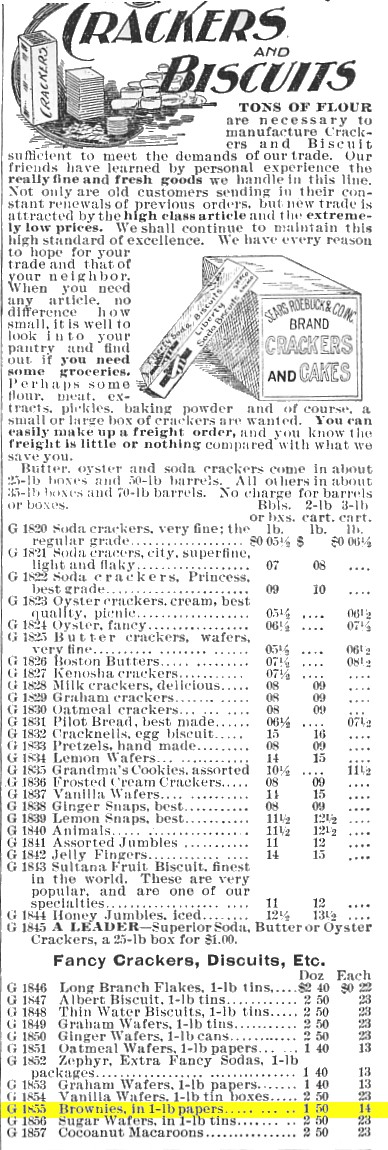
Kansas City Journal April 1, 1898 page 12
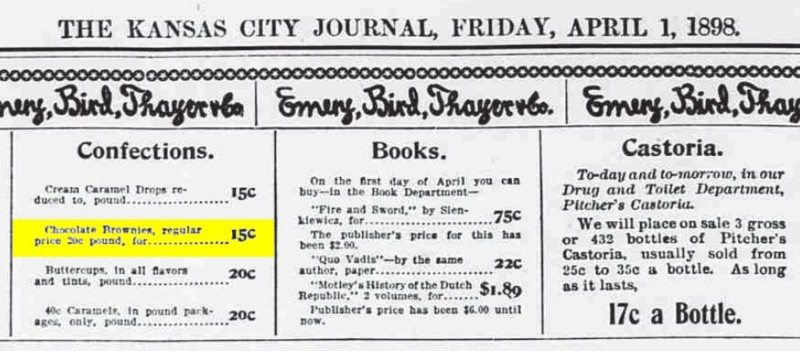
The Minneapolis Journal March 29, 1901 Page 5, 1st column
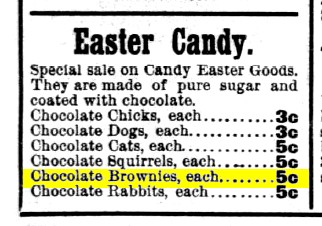
The Washington Times December 13, 1903 Page 16

The Washington Times December 22, 1905, page 3, bottom center
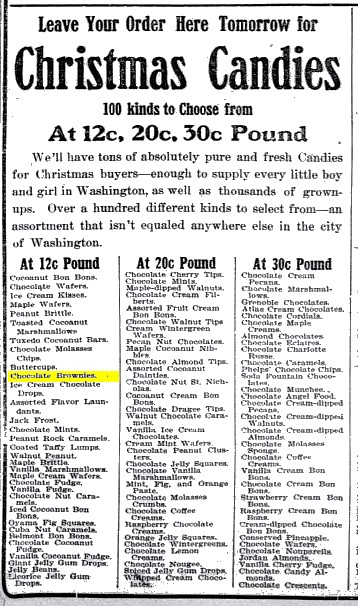
The Washington Times December 20, 1907, page 5, bottom center
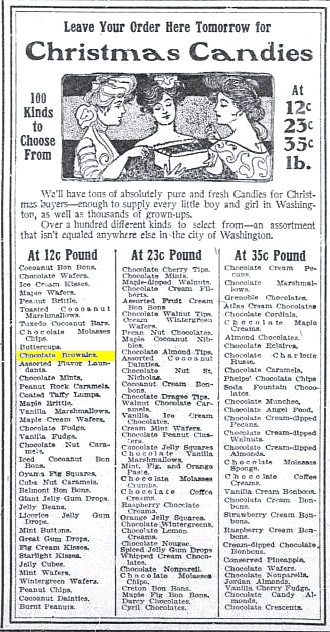
* All newspaper images courtesy of the Library of Congress Chronicling American Collection
Boston Cooking School Cookbook (1896) page 424
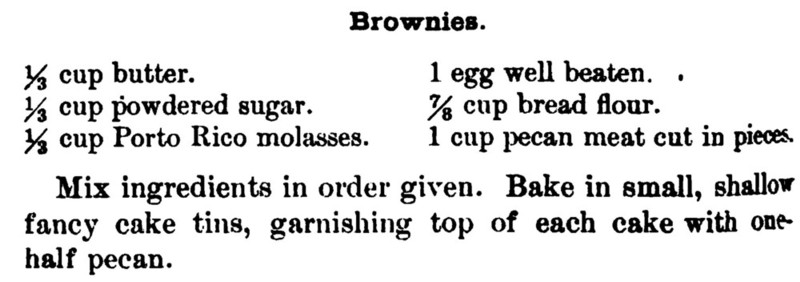
Home Cookery (1904, Laconia, NH) page 132
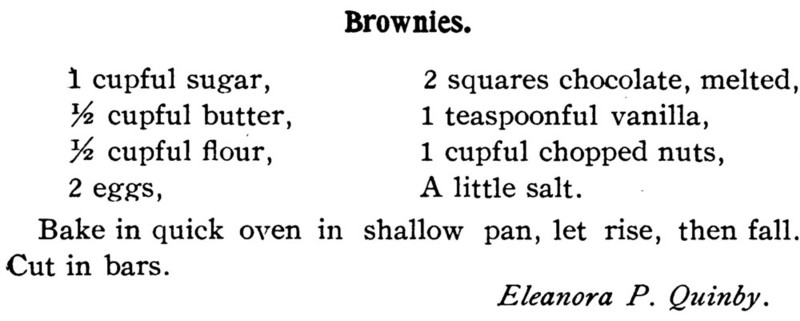
Service Club Cook Book (1904, Chicago, IL) page 68

Lowney’s Cook Book (1907, Boston, MA) page 261
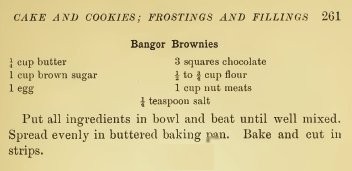
Lowney’s Cook Book (1907, Boston, MA) page 265
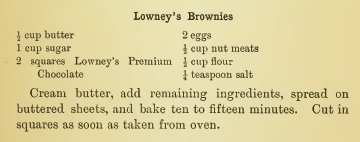
Boston Cooking School Cookbook (Revised Edition, 1910) Page 495
